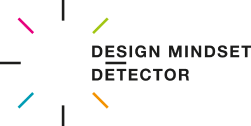Why is it worth developing a Design Mindset?
Understanding the characteristics of the thinking and acting styles of designers, as well as measuring current predispositions, opens up new development opportunities – for individuals, teams, and entire organizations.
Many companies today undertake projects using methods borrowed from the world of design, particularly in the context of product and service design, with an emphasis on user experiences (User Experience, Customer Experience). A Design Mindset is the foundation of such activities.
Access to natural predispositions

What is DESIGN?
What is DESIGN THINKING?
What is DOUBLE DIAMOND?
- Exploration (Discover) – a stage of broad research, gathering materials, and inspiration for further work.
- Analysis (Define) – analyzing the collected materials, looking for patterns, and defining guidelines using tools such as Personas and Customer Journey Maps.
- Ideation (Develop) – creating concepts, prototyping, and testing potential solutions.
- Implementation (Deliver) – refining the final solution through successive tests until its final implementation.
What is DESIGN MINDSET?
Design Mindset is a set of predispositions for thinking and acting characteristic of designers. According to the independent research institution Institute for the Future from Palo Alto, California, Design Mindset is one of the foundations of the future of work.
We rely on specific knowledge and research on design activities and the behaviors of designers. These studies show that certain predispositions aid in design, supporting the resolution of so-called wicked problems. These abilities are highly developed – through studies and design practice – in qualified designers, but everyone possesses them to some extent.
Most importantly, the Design Mindset can be developed. Awareness of its components allows one to pay attention to specific situations and facilitates the introduction of changes in daily work. It is also possible to develop these predispositions by participating in recommended training and workshops.
- Article by Magda Kochanowska and Weronika Rochacka Gagliardi for DesignAlive
- Future Work Skills Report by Institute for the Future
- “Sustainable design mindset” – Article by Magda Kochanowska for Gdynia Design Days
- “Set a Goal and Choose a Path” – Article by Maciej Mazerant for PURPOSE
- “How to Design Your Service” – Article by Weronika Rochacka Gagliardi for PURPOSE
